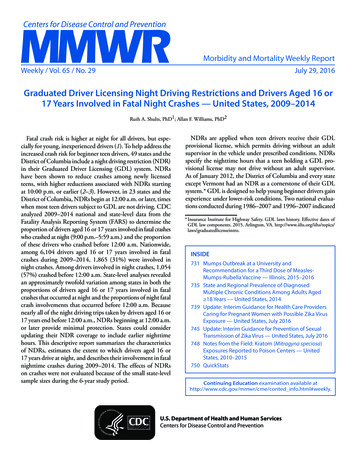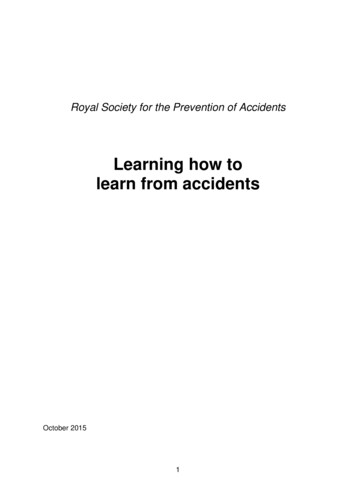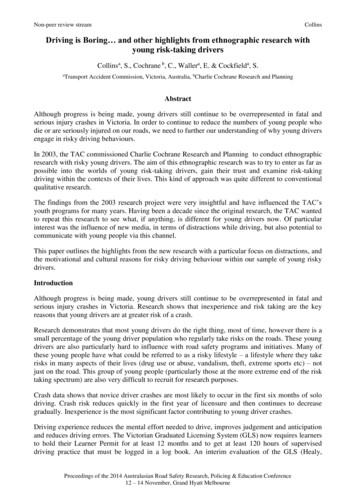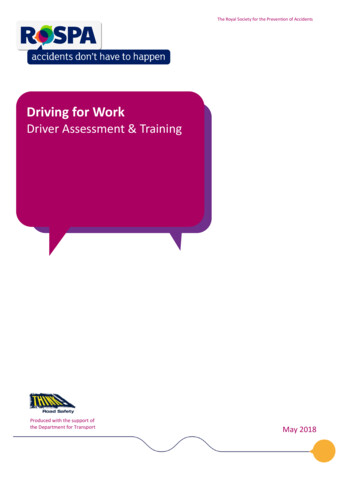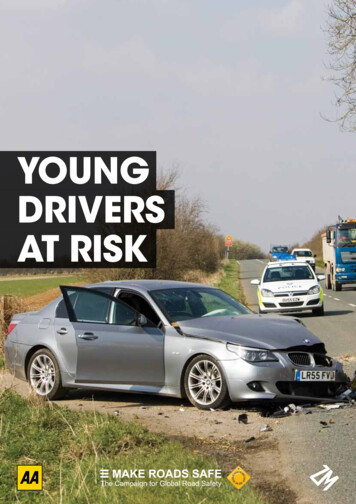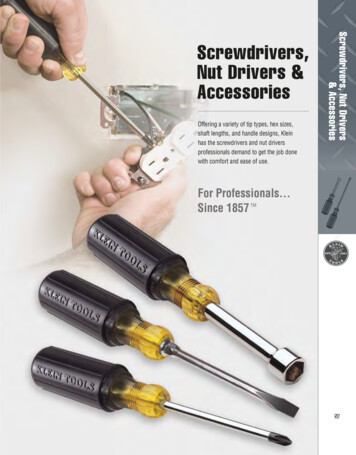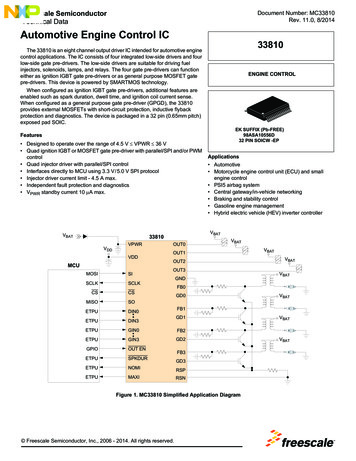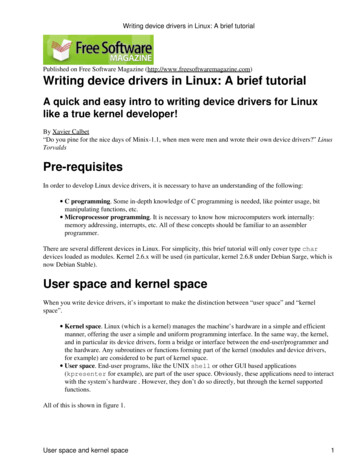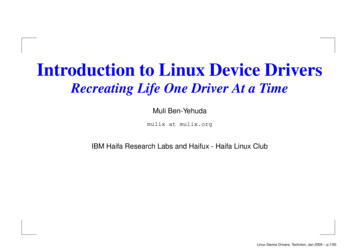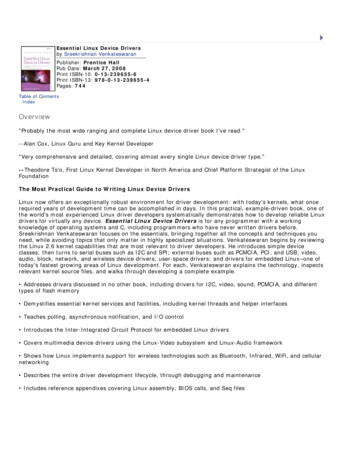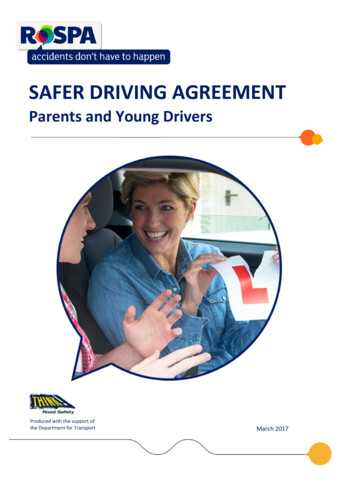
Transcription
SAFER DRIVING AGREEMENTParents and Young DriversProduced with the support ofthe Department for TransportMarch 2017
Safer Driving AgreementYoung DriversLearner drivers have few accidents because they are always under supervision. But, once they have passedtheir test, and can drive unsupervised, their chances of crashing increase dramatically.Young novice drivers are much more likely to crash than experienced drivers, especially in their first year ofdriving, despite driving far less.Young drivers are more likely to be involved in: high speed crashescrashes caused by losing control of the vehiclecrashes in the darkcrashes when overtaking and negotiating bends.Why?Lack of ExperienceThis is one of the main reasons. As new drivers gainmore driving experience their accident rate beginsto fall, especially after the first 1,000 miles ofdriving.Hazard PerceptionCrash rates for newly qualified young drivers aremuch higher than for newly qualified older drivers.Young drivers often have excellent vehicle controlskills and fast reactions. But, they are poor atidentifying potential hazards and assessing risk,and tend to overestimate their ability to avoid thehazard and accident. New drivers take longer toreact to hazardous situations than moreexperienced drivers.AttitudeImpairmentYoung drivers, especially men, tend to be overconfident and more likely to drive in risky ways:too fast, too close to the vehicle in front anddangerous overtaking. They consistently rate theirown performance as above average and are morelikely to regard ‘good’ driving as the ability tohandle the car at higher speeds.Younger drivers are affected more thanexperienced drivers by alcohol, drugs, fatigue anddistractions, such as mobile phones.AgeGenderNovice male drivers have higher accident ratesthan novice female drivers, and are more likely tocommit driving offences.Peer PressureWhen young drivers, especially men, carry theirfriends they are more likely to be distracted or tomess around and show off while driving.Motor InsuranceYoung drivers are also more likely to make an insurance claim than other drivers, and on average, their claimsare much more expensive. This is why motor insurance premiums for young drivers are much higher than forother drivers.
Safer Driving AgreementHow Can You Help?The good news is that there are some simple steps that parents and young drivers can take together to reducethese risks, and probably the cost of insurance.TelematicsLet Them Drive YouMany motor insurers offer telematics policies thatinvolve the driver having a small device (a ‘blackbox’) installed or using an app on a smartphone.Some policies begin with an app, as a way of tryingit, before having a black box fitted.When travelling with your son or daughter, letthem drive to increase their experience. Offerconstructive advice, but don’t be a back seatdriver!Telematics can help a new driver to improve theirdriving and reduce their insurance premiums bymonitoring how they drive. If they driveresponsibly and avoid high risk situations (such asdriving in the early hours) they may be rewardedwith a discount on their premiums or anotherbenefit (such as more miles). But, if they drivepoorly (for example, speeding or harsh braking),they get a lower score and their premiums mayincrease.Telematics can significantly reduce risky drivingPass PlusSafer Driving AgreementMake a Safer Driving Agreement between you.In some countries, young drivers get a restricteddriving licence for the first year or so after passingtheir driving test. For example, they cannot drive atnight (often between midnight and 6am) or carrypassengers of their own age, unless there is anexperienced driver in the car. This is known asGraduated Driver Licensing, and helps to keep thenew driver away from higher risk situations for ashort period of time, while they develop theirdriving experience. Research shows it can be veryeffective at reducing young driver crashes.Pass Plus helps new drivers improve their skills andwiden their driving experience. It involves extradriving lessons in different conditions (at night andon urban and rural roads, dual carriageways andmotorways). Once completed, drivers might beable to obtain reduced insurance premiums fromsome insurance companies.While this system is not used in the UK, a voluntaryparent/young driver agreement can create some ofthe effects. They are popular in some countries.The new driver is allowed to drive the family car (ortheir own car if you help to fund it) unsupervised, ifthey agree to certain conditions for the first year orso of driving.Only Pass Plus registered approved drivinginstructors (ADIs) can run Pass Plus courses. Seewww.gov.uk/pass-plus for more details. Ask theroad safety department of your council ifsubsidised courses are available.This keeps them away from situations that aremost likely to lead to crashes while they gainexperience.Useful -pluswww.gov.uk/highway-code
Safer Driving AgreementSafer Driving AgreementsSafer Driving Agreements are flexible and tailored to individual circumstances. They can be verbal or written(see the example on the next page), and can support telematics insurance if the driver has such a policy. Theyare not about being over-protective or unreasonable but help the parent and the young driver to agreeparameters for safer driving during the initial high risk period while they build up their experience. Theyusually cover some or all of the following:Driving at NightAlcohol and DrugsYoung drivers are more likely to crash at night, soconsider agreeing that they will not drive betweenmidnight (or earlier) and 6:00 am. The exact timescan be relaxed as driving experience increases.Ask the young driver to stick to a zero limit whendriving, and not to accept a lift with any driver whohas been drinking or might have taken drugs. Set agood example yourself.FriendsMobile PhonesConsider agreeing a limit on the number of friendsthey carry if you are not in the car. Passengernumbers can be increased as experience is gained.Most young drivers will have a mobile phone.While this is useful in case they need to contactyou, it is dangerous to use it while driving. Ask yourson or daughter to agree only to use their phonewhilst parked. Remind them that the penalty forusing a hand-held phone is a 200 fine and sixpenalty points, which means they could lose theirlicence for a single offence (see below).SpeedYoung drivers are prone to approaching bends toofast and to dangerous overtaking. Driving too fastfor the conditions (even within the speed limit) canbe unsafe, for example on wet or icy roads or onnarrow, winding rural roads. Discuss these riskswith your young driver.Seat BeltsAsk your young driver to always wear their seatbelt and to ask their passengers to wear theirseatbelts. Set an example by always wearing yours.Further TrainingOther distractions, such as loud music, eating,drinking and smoking, or messing around withfriends, while driving also increase the risk ofcrashing or being stopped by the Police.‘P’ PlatesGreen ‘P’ ’plates can be displayed to indicate toother road users that there is an inexperienceddriver at the wheel.Encourage your young driver to take furthertraining.Penalty PointsMake sure your young driver knows that if they acquire six or more penalty points within two years of passingtheir driving test, their licence will be revoked. They must then obtain a provisional licence, drive as a learner(i.e., display an ‘L’ Plate and be supervised) and pass the theory and practical driving tests again. This couldhappen if they use a hand-held mobile phone while driving just once. The penalty points will remain on theirnew licence. For more details see -drivers.
Safer Driving AgreementSafer Driving AgreementYoung DriverI promise to: Confirm my destination in advanceDrive only during the following timestoOnly give a lift to 1/2/3* passengers unless you are also in the carNever drink alcohol or take drugs and driveNever accept a lift from a driver who has drunk alcohol or taken drugs, and to find alternative transport orcall you and ask you to collect me or pay for a taxi, with no questions asked at the time.Always wear my seatbelt and ensure that my passengers do the same.Obey traffic laws, including speed limits and parking restrictions.Never use a mobile phone while driving, only when parked with the engine switched offAvoid distractions whilst driving – like fiddling with the stereo, smoking, eating and drinkingTelephone you if I’m going to be later than expectedParentI promise to: Always wear my seatbelt and ensure my passengers do the sameNever drink alcohol or take drugs and driveObey traffic laws, including speed limits and parking restrictionsNever use a mobile phone while driving, only when parked with the engine switched offAccept a call from you at any hour and either collect you or pay for a taxi for you to get home, with noquestions asked at the timeRemain calm and constructive when travelling in the car with you and accept that mistakes are animportant part of learning.We will review this agreement onSigned: (parent)Signed: (son/daughter)Date:*Delete as necessary
Young novice drivers are much more likely to crash than experienced drivers, especially in their first year of driving, despite driving far less. Young drivers are more likely to be involved in: high speed crashes crashes caused by losing control of the vehicle crashes in the dark crashes when overtaking and negotiating bends.
